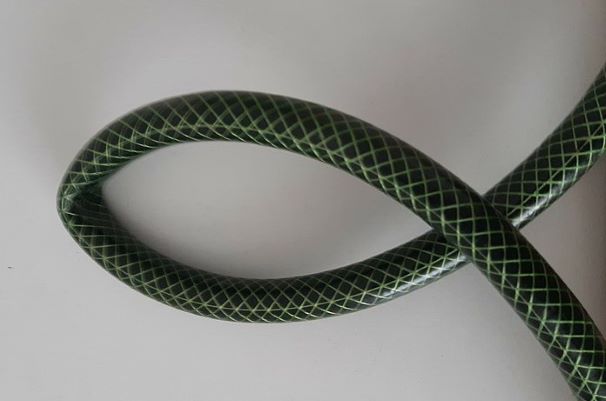Why Is My Dehumidifier Not Draining With The Hose? Main Reasons and Fixes
Dehumidifiers pull in the wet air, pass it through the filters, and suck out the excess moisture out of the air like tiny sponges.
They then have to dispose of the collected moisture, either through the dehumidifier bucket or through the dehumidifier drain hose.
Also, some dehumidifiers with built-in pumps can dump the collected water over a vertical distance.
But what happens when your trusty warrior becomes…waterlogged, simply because it won’t drain through the hose? That is what we will find out here.
But first, a list of the reasons:
- Clogged drainage
- Kinked or crushed hose
- No gravity
- Submerged drain outlet
- Faulty drain pump
- Broken drain connection
- P-trap problems
- Temperature troubles
- Sensor mishaps
- The bucket is removed
- You forgot to remove the caps
- Evaporator coil issues
- Manufacturer defects
- Time for a tune-up
14 causes of a sluggish drain for dehumidifier

Many things could go wrong, even with the most well-built dehumidifier. For instance, I have experienced a Midea dehumidifier not collecting water in the past.
Do not panic. First, try to identify the probable causes of your unit not draining water. Here are some of the main culprits:
1. Clogged drainage system
Just like arteries can get blocked with cholesterol, so too can your dehumidifier’s internal drainage pathway. Dust, mold, and mineral buildup can all conspire to create a watery roadblock.
2. Kinked or crushed hose
A hose isn’t a contortionist. Bending it sharply or flattening it with furniture can impede the flow of water, turning it into a stagnant puddle instead of a gurgling stream.
Check this first. It is usually to blame, at least in about 80 percent of the cases.
3. Improper slope
Gravity is the silent partner in drainage. If the hose lacks a downward slope, the water might just sit there, refusing to budge like a stubborn mule.
In my post on whether to place a dehumidifier on the floor or up high, keeping it elevated not only helps with airflow, but water flow through the hose as well.
4. Submerged drain outlet
Remember, water seeks its level. If the hose end dips into standing water, like a drain line that’s too full, it can create a backflow situation, trapping water inside the dehumidifier.
5. Faulty drain pump
Just like any mechanical marvel, built-in dehumidifier drain pumps malfunction at times. If the pump isn’t working, it’s simply not strong enough to push the water through the hose, leaving it to pool like a forgotten promise.
6. Broken drain connection
Leaks can happen anywhere, even at the point where the hose connects to the dehumidifier.
A cracked or loose connection can divert the water away from its proper path, leaving the hose high and dry (well, mostly dry).
7. P-Trap (drain trap) problems
For some large-sized dehumidifiers, a p-trap, a U-shaped plumbing fixture, helps prevent sewer gases from back flowing into the unit. However, a clogged or improperly installed p-trap can also become a barrier to smooth drainage.
8. Temperature troubles
Dehumidifiers tend to prefer warmer temperatures (15 to 30 degrees Celsius). If the surrounding air is too cold, ice buildup can occur within the drainage system, effectively plugging it up like a frozen faucet.
9. Sensor mishaps
Some dehumidifiers have sensors that detect when the drain pan is full and turn off the unit. If the sensor malfunctions, it might mistakenly think the pan is full even when the hose is clear, leading to premature shutdowns.
10. The bucket is removed
Some units will simply not work when the dehumidifier bucket is removed. Therefore, just leave it intact, even if you intend to use a drain hose with the unit.
The same will also happen when the bucket is full of water, so you should empty it first.
11. You forgot to remove the drain port plug
When a dehumidifier is packed for delivery, it has plastic caps covering every outlet, or drain outlet. If you forget to remove this, there is no way that the water will get to the drain hose. Also, check that you have removed the plastic plugs on both ends of the hose.
12. Evaporator coil issues
The evaporator coil plays a crucial role in dehumidification. If it’s iced over or is malfunctioning, it can impact the overall drainage process, leading to sluggish flow or even complete stagnation. It is vital to clean the dehumidifier coils to keep them working properly.
13. Manufacturer-specific defects
Not all dehumidifiers are created equal. Some brands or models might have specific quirks or issues that affect drainage.
Consulting the user manual or manufacturer website can reveal hidden troubleshooting tips.
14. Time for a tune-up
Regular maintenance is key to any equipment’s longevity. If you don’t know how to clean a dehumidifier, buildup and grime might be hindering its optimal performance, including drainage.
How to fix a dehumidifier that won’t drain through the hose

The fix for this problem often depends on the culprit. But a good first step is to unplug the dehumidifier for safety. Then, tackle the most likely suspects:
Clean the hose and drain connections with a brush and warm water.
Straighten any kinks or loops in the hose and ensure it slopes downward if the dehumidifier does not have a pump.
Check for blockages in the internal drainage system and clear them gently.
Inspect the drain pump for signs of wear or damage.
Consult the user manual for specific troubleshooting instructions for your model.
If these basic steps don’t work, consider seeking professional help from a qualified technician. If you suspect manufacturing defects, return the unit if the warranty is still valid.
Brand-specific troubleshooting
While the general principles remain the same, specific issues might arise with different brands.
Here are some pointers for popular dehumidifier models:
Frigidaire dehumidifier not draining
Some Frigidaire dehumidifier models have a sensor in the drain pan that can become dislodged. Check for proper positioning and clean it if necessary.
Check the general health of the unit as a whole. For instance, if your Frigidaire dehumidifier blows hot air, it might not be working properly. Check whether the hose is still draining water.
LG dehumidifier not removing water through the hose
LG dehumidifiers sometimes have an overflow switch that can trip prematurely. Consult the manual for dehumidifier resetting instructions. If your dehumidifier blows hot air and does not drain water, something could be wrong with the compressor. Check it!
GE dehumidifier fails to drain water
GE dehumidifier not working can occur because of a failed drain hose. Some GE models have a float switch in the drain pan that might stick.
Gently move it to ensure it is operating freely.
Wrapping it up
Don’t let a dehumidifier drainage drama dampen your spirits! With the tips I have shared with you here, you can try to check a few things, and if they don’t solve the issue, you can take the unit to a technician.
Always start with the simple fixes for your dehumidifier before you can take it to the technician.
Also, know how your unit works by using the manual to set it up and troubleshoot when there are problems. Knowing the dehumidifier symbols meanings can help you know when something is wrong.

